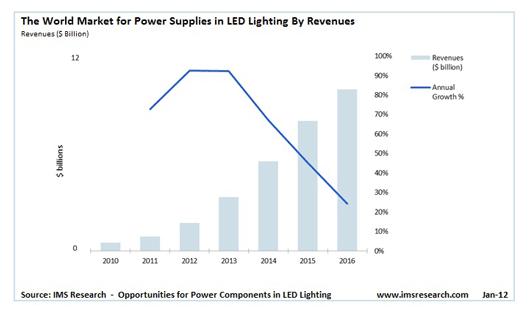- News
6 February 2012
LED lighting power supply market to reach $10bn in 2016
Due to legislation and rising costs of electricity, the rapid uptake of LED lighting is forecast to result in a potential global market of 4 billion power supply units by 2016, worth $10bn, according to the report ‘Opportunities for Power Components in LED Lighting’ from IMS Research.
“Demand for LED lighting solutions is increasing rapidly for all applications from low-power residential retrofit LED lamps and bulbs to high-power commercial and industrial LED luminaires for applications such as street lighting,” comments co-author and senior market analyst Ryan Sanderson.

The report also found that the traditional lamp and luminaire market is well established. Manufacturers are faced with new challenges when it comes to powering LED lamps and luminaires and often require significant power electronics expertise, opening up opportunities for power supply manufacturers. The requirements to power new LED lighting products varies widely, depending on design factors including power rating, the number of LEDs or LED strings and the environment in which the solution will be placed. "These design requirements, coupled with the lack of clear standards for LED lighting, means that LED lamp and luminaire manufacturers need considerable power electronics expertise, either via employing specialists or from a merchant power supply manufacturer,” says Sanderson.
The report found that LED lighting would become a unique opportunity, despite the fact that general lighting has always been a relatively small and low-growth market for the power supply industry. However, competition in lighting is already fierce, and some of the largest manufacturers of LED lamps and luminaires are positioning themselves to cope with these challenges internally.
“Some of the largest manufacturers of LED lamps and luminaires already have the capability to design and manufacture power circuitry in-house, either via subsidiaries or through the acquisition of power supply manufacturers… Philips Advance is a prime example," says co-author and market analyst Jonathon Eykyn. This means that a portion of the total power supply opportunity is absorbed by these vertically integrated companies and becomes ‘captive’. “Designing and manufacturing the power solution in-house, however, only really makes sense in high-volume, low-cost markets and where the design is simple; for example, LED retrofit lamps,” adds Eykyn. "In medium- and high-power applications, design becomes more complex and it often makes more financial sense to outsource the power supply design to a merchant vendor.”
As a result, the report forecasts that more than 50% of the market in 2016 will be controlled by merchant power supply manufacturers.
